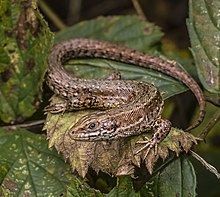| Viviparous lizard | |
|---|---|

| |
| Scientific classification | |
| Domain: | Eukaryota |
| Kingdom: | Animalia |
| Phylum: | Chordata |
| Class: | Reptilia |
| Order: | Squamata |
| Family: | Lacertidae |
| Genus: | Zootoca |
| Species: | Z. vivipara
|
| Binomial name | |
| Zootoca vivipara (Lichtenstein, 1823)[2]
| |

| |
| The viviparous lizard is found across Northern Europe through Central Asia, ranging further north than any other land-dwelling reptile. | |
| Synonyms | |
|
Lacerta vivipara Lichtenstein, 1823 | |
The viviparous lizard, or common lizard, (Zootoca vivipara, formerly Lacerta vivipara) is a Eurasian lizard. It lives farther north than any other species of non-marine reptile, and is named for the fact that it is viviparous, meaning it gives birth to live young (although they will sometimes lay eggs normally).[3] Both "Zootoca" and "vivipara" mean "live birth", in (Latinized) Greek and Latin respectively. It was called Lacerta vivipara until the genus Lacerta was split into nine genera in 2007 by Arnold, Arribas & Carranza.[4]
Male and female Zootoca vivipara are equally likely to contract blood parasites.[5] Additionally, larger males have been shown to reproduce more times in a given reproductive season than smaller ones.[6]
The lizard is also unique as it is exclusively carnivorous, eating only flies, spiders, and insects.[7] Studies show that the more carnivorous an individual is (the more insects they eat), the less diverse the population of parasitic helminths that infest the lizards.[7]
Zootoca vivipara lives in very cold climates, yet participates in normal thermoregulation instead of thermoconformity.[8] They have the largest range of all terrestrial lizards which even include subarctic regions. It is able to survive these harsh climates as individuals will freeze in especially cold seasons and thaw two months later. They also live closer to geological phenomena that provide a warmer environment for them.[8]
- ^ Aghasyan, A.; Avci, A.; Tuniyev, B.; et al. (2019). "Zootoca vivipara". IUCN Red List of Threatened Species. 2019: e.T61741A49741947. doi:10.2305/IUCN.UK.2019-2.RLTS.T61741A49741947.en. Retrieved 12 November 2021.
- ^ Friedrich Schmidtler, Josef & Böhme, Wolfgang (2011). "Synonymy and nomenclatural history of the Common or Viviparous Lizard, by this time: Zootoca vivipara (Lichtenstein, 1823)" (PDF). Bonn Zoological Bulletin. 60 (2): 214–228.
- ^ Cite error: The named reference
Daywas invoked but never defined (see the help page). - ^ Arnold, E. Nicholas; Arribas, Oscar; Carranza, Salvador (2007). "Systematics of the Palaearctic and Oriental lizard tribe Lacertini (Squamata: Lacertidae: Lacertinae), with descriptions of eight new genera" (PDF). Zootaxa. 1430. Auckland, New Zealand: Magnolia Press: 1–86. doi:10.11646/zootaxa.1430.1.1. ISBN 978-1-86977-097-6. Retrieved 12 July 2017.
- ^ Majláthová, Viktória; Majláth, Igor; Haklová, Božena; Hromada, Martin; Ekner, Anna; Antczak, Marcin; Tryjanowski, Piotr (2010-10-01). "Blood parasites in two co-existing species of lizards (Zootoca vivipara and Lacerta agilis)". Parasitology Research. 107 (5): 1121–1127. doi:10.1007/s00436-010-1981-0. ISSN 1432-1955. PMID 20661747. S2CID 13131577.
- ^ Gvozdík, Lumír; Van Damme, Raoul (2003). "Evolutionary maintenance of sexual dimorphism in head size in the lizard Zootoca vivipara: a test of two hypotheses". Journal of Zoology. 259 (1): 7–13. doi:10.1017/S0952836902003308. ISSN 1469-7998.
- ^ a b Sanchis, Vanessa (2000). "Host-parasite relationships of Zootoca vivipara (Sauria: Lacretidae) in the Pyrenees (North Spain)". Folia Parasitologica. 47 (2): 118–122. doi:10.14411/fp.2000.024. PMID 10945736.
- ^ a b Herczeg, Gábor; Kovács, Tibor; Hettyey, Attila; Merilä, Juha (2003-07-01). "To thermoconform or thermoregulate? An assessment of thermoregulation opportunities for the lizard Zootoca vivipara in the subarctic". Polar Biology. 26 (7): 486–490. Bibcode:2003PoBio..26..486H. doi:10.1007/s00300-003-0507-y. ISSN 1432-2056. S2CID 34229903.
